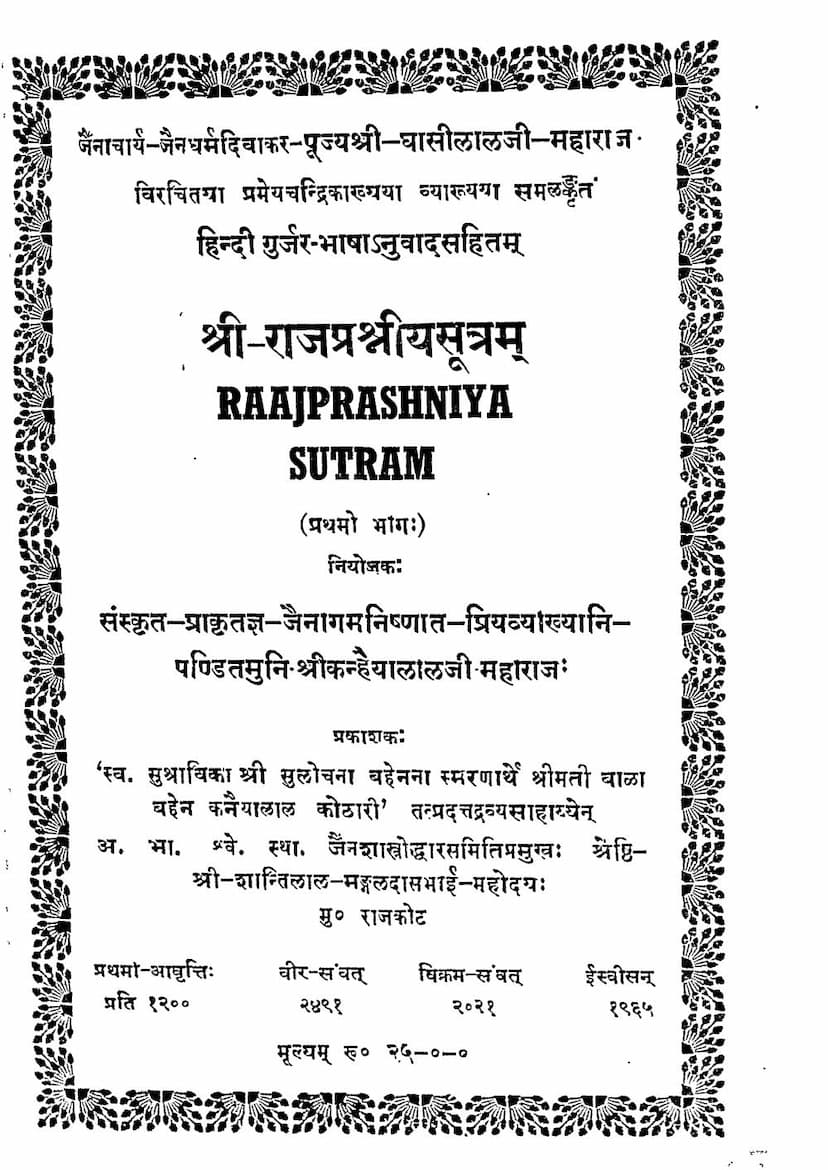Rajprashniya Sutra Part 01
Added to library: September 2, 2025

Summary
Rajprashniya Sutra Part 01 - Comprehensive Summary
This document is the first part of the "Rajprashniya Sutra," a Jain religious text authored by Ghasilal Maharaj. Published by A B Shwetambar Sthanakwasi Jain Shastroddhar Samiti, the text, in its first edition from 1965, is presented with a Hindi-Gujarati translation and a commentary named "Subodhini." Pandit Muni Shri Kanhaiyalalji Maharaj is credited as the planner, and Shrimati Valahen Kanhaiyalal Kothari, in memory of Sushravika Shri Sulochana Behen, supported its publication.
The initial pages of the document are dedicated to honoring Sushravika Shri Sulochana Behen. It details her life, starting with her birth on March 4, 1927, in Palanpur, Gujarat. Her early childhood was spent in Rangoon, Burma, where her father, Shri Kanhaiyalal Chimnalal Ker, was in business. Later, the family relocated to Mumbai. Sulochana Behen received her education at Chandrarayji Girls High School and later pursued medicine at Grant Medical College in Mumbai, completing her MBBS in 1952. She served as a houseman at Harkishondas Hospital, assisting her father. Her marriage took place in January 1953 with Dr. Vasantalal Gulabchand Shah, a resident of Rajkot. Following their marriage, they both joined the "Bharat Arogya Nidhi" in Patan, Gujarat. They then pursued further medical studies in England, where she obtained her D.A. degree, and her husband became an RCS, specializing in thoracic surgery. In 1960, they gained further surgical experience in the United States. Despite living in challenging foreign environments, she continued her religious practices, observing fasts and adhering to a pure vegetarian diet. Her compassionate nature led her to help the poor, often providing medicines at her own expense, embodying the spirit of "You shall not die because you have no money." Her untimely demise occurred on July 13, 1963, in England, due to a sudden heart attack. The text highlights her strong religious convictions, noting that she had recorded religious discourses shortly before her death.
Following this tribute, the document presents the Table of Contents for "Shri Rajprashniya Sutra Vol. 1," outlining 38 topics covered in the text, ranging from Mangalacharan (Invocation) and descriptions of cities like Amalkalpa Nagari to detailed discussions on deities like Suryabhadev, celestial vehicles, assemblies (Samavsarana), spiritual practices, and philosophical questions. The text delves into various aspects of Jain cosmology, asceticism, and the teachings of Lord Mahavir.
The Mangalacharan section begins with verses in Malini and Bhujangaprayat meter, offering salutations to Lord Jinendra Vir and Ganadhar Gautam, followed by prayers to Goddess Sharada (Saraswati) for the ability to expound the scriptures. The commentary, "Subodhini," explains the significance of the epithets used for Lord Mahavir and the merits of Ganadhar Gautam, emphasizing the path of righteousness and liberation through devotion and self-control.
The initial chapters describe the city of Amalkalpa Nagari, its grandeur, and the presence of Lord Mahavir. It then shifts focus to Suryabhadev, a celestial being from Saudharmakalpa, who, through his divine knowledge, observes the entire Jambudweep. Impressed by Lord Mahavir's presence and his spiritual radiance, Suryabhadev decides to visit him. The narrative details the elaborate arrangements made by Suryabhadev and his retinue for this celestial visit, including the creation of magnificent flying vehicles (Viman), decorated with precious stones, and the meticulous preparation of the ground, including cleaning, perfuming, and adorning the path with flowers.
The text then elaborates on the Suryabhadev's Vandan (Salutation) to Lord Mahavir. It describes Suryabhadev's respectful approach, prostrating himself three times, offering prayers, and introducing himself. Lord Mahavir's discourse to Suryabhadev is also mentioned, emphasizing his duties and the significance of spiritual pursuit.
A substantial portion of the text is dedicated to the description of the divine chariot (Yan) created by Suryabhadev. This description is incredibly detailed, focusing on its opulent construction, the intricate artistry, the precious materials used, and the celestial beauty of its various parts, including its pillars, gates, thrones, and decorative elements like divine music and floral offerings. The narrative also details the procession of Suryabhadev, accompanied by his divine entourage, including his queens, generals, soldiers, and celestial attendants, all participating in a grand spectacle.
The text then shifts to the divine celestial beings descending to the earthly realm, specifically to Amalkalpa Nagari, to witness Lord Mahavir's discourse. The meticulous preparations for the Samavsarana (divine assembly) are described, highlighting the meticulous arrangements made by the celestial beings to honor the presence of Lord Mahavir and the divine beings.
Further, the text outlines the performance of a divine ballet (Natya Vidhi) by celestial beings, illustrating various forms of dance and music. This section describes different dance styles, musical instruments, and the overall artistic presentation, emphasizing the divine nature of these performances. The narrative then highlights Lord Mahavir's compassionate response and guidance to Suryabhadev, assuring him of his ultimate salvation and guiding him on the path of righteousness.
Finally, the text concludes the description of Suryabhadev's celestial chariot (Viman), detailing its intricate design, its precious materials, and its divine splendor. The journey's narrative also mentions the presence of various celestial beings, such as musicians, dancers, and attendants, all contributing to the grand procession. The text reiterates that the descriptions of these divine embellishments are elaborate and meant to convey the magnificence of the celestial realm.